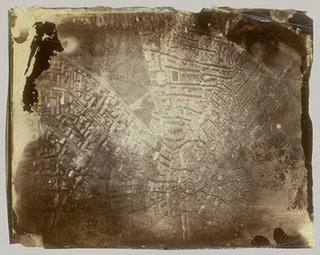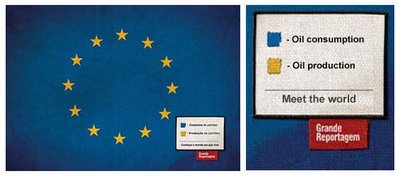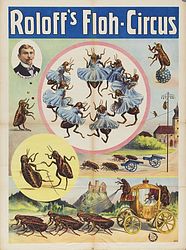
David Roberts makes some excellent points in his preamble to an interview with Salt Lake City mayor Rocky Anderson:
As mayor of his city, Rocky Anderson has been unapologetically liberal. He's pushed through aggressive sustainability measures and energetically championed affirmative action, gay rights, and reform of the penalty-heavy justice system. He's also been a fierce and vocal critic of the Bush administration in general and the war in Iraq in particular.Engineer-Poet has an amazing post on the use of cold-storage warehouses as gigantic “batteries” for storing energy generated by wind power:
His city? Salt Lake City, Utah, square in the middle of the reddest state in the Union -- the state with the highest percentage of Bush votes in 2000, a number that increased in 2004.
The real trick is, he's done all this while remaining extraordinarily popular; he was reelected in 2003 by a wide margin. He's even won over the business community, which was skeptical if not hostile at the start of his first term.
During periods of power surplus, the warehouses' refrigeration systems will be run full-bore to chill them by up to 1°C; when power production lags demand, the warehouses will shut off their chillers and coast on their stored heat-absorption capabity.He also discusses a solid-oxide fuel cell powered by gasified chicken litter, and concludes “we look to be on-track for a Viridian green future, too late for comfort but sooner than anyone expects.”
Motorola is setting up wind and solar generators for its GSM cell sites in Namibia:
The use of alternative power sources makes it potentially more viable for operators to connect people in remote communities with little existing infrastructure or even roads. Motorola has gone for a combined wind and solar powered system (rather than selecting one or the other) because the same rig can be used in a variety of different environments….Excess power from wind and solar systems might be either sold to power-generating firms, where connections to a grid are possible, or supplied as a resource to the community around a base station.Bruce Schneier spotlights the innovative security system for the One Laptop Per Child program:
We have set out to create a system that is both drastically more secure and provides drastically more usable security than any mainstream system currently on the market. One result of the dedication to usability is that there is only one protection provided by the Bitfrost platform that requires user response, and even then, it's a simple 'yes or no' question understandable even by young children. The remainder of the security is provided behind the scenes.There are more details here, including a clever anti-theft system. There’s also interesting work being done on a “$10 Laptop,” which comprises "a Linux OS image running Sugar on a USB stick." More details here and here.
I’ve discussed the use of pay toilets in India before. A new article goes into more detail:
These toilets are affordable for the poor, and the cheapest model can be constructed for as little as $10….Sulabh's systems often come with an innovative modification: the attachment of a biogas plant. Through these plants, human waste produces biogas that, when mixed with diesel fuel, can power electrical devices such as streetlights. A similar technique of wet-sanitation is being replicated elsewhere in India by groups like BORDA.In 1990, only 20 percent of India’s population had access to clean drinking water. Currently, the figure is about 85 percent, thanks to improved sanitation.
An Australian inventor is working on a windmill that’ll condense water out of air:
His solution is an innovative windmill which, unlike the conventional three blades, has several blades arranged around a vertical column that can take wind from any direction. The secret lies in a cooling process kicked off by the blades which propel the air into a "chiller" box where water molecules condense on specially designed plates. Whisson points to ancient tribes in the area that is now Ukraine who used pyramid-shaped rock structures to cool air and produce their water. The design of his collection plates was also assisted by analysing the body of a beetle that has adapted to its harsh desert environment in Namibia.The European Commission hopes to harmonize laws and penalties that apply to pollution and other environmental crimes. The usual complaints about infringement on national sovereignty are being made, but as the Commission notes, these objections are incoherent:
"Environmental crime usually has cross-border implications, as it often involves trans-boundary activities and often has trans-boundary effects such as the resulting pollution of the environment", the paper states.The Norwegian battery-powered car Think is going back into production. Its former manufacturer declared bankruptcy, after buying the company from Ford in 2002. The first cars will be available in summer. They’ll allegedly go 180 km between charges, and reach a top speed of 100 km.
In related news, Technology Review reports on the possibility of self-assembling batteries.
Researchers at MIT have designed a rechargeable lithium-ion battery that assembles itself out of microscopic materials. This could lead to ultrasmall power sources for sensors and micromachines the size of the head of a pin. It could also make it possible to pack battery materials in unused space inside electronic devices.In science-journalese, the word “could” tends to mean “there’s almost no chance it’ll work, but we’d still like huge amounts of funding.” All the same, the prototype is fascinating, so I thought it was worth a mention.
BLDGBLOG has an odd story on the growth of “novel forms of bacteria and fungi” in a flooded, highly contaminated open-pit mine:
These include "a strain of the pithomyces fungi" that, if used medically, "could block headaches," and "a strain of penicillium fungi" that might help prevent "the growth of lung cancer cells."There’s that “could” again! The medical possibilities are certainly intriguing, but not as intriguing as the notion that we’re witnessing the first stirrings of the mineral race described in Joseph-Henri Boex’s Les Xipehuz (1887).
Speaking of interspecies conflict, Janice Neitzel at Triple Pundit reports that Smithfield Foods is phasing out its use of gestation crates:
My colleague emailed me last week, “I never thought I’d see this, not in my lifetime.” On January 25, 2007, Smithfield Foods, the largest pork producer in the U.S., announced it will be phasing out hog gestation crates over the next decade. Several days later, Maple Leaf Foods, Canada’s largest pork producer followed suit.Oddly enough, Smithfield claims that they’ve made this decision in response to demands by Wal-Mart and McDonald’s.
A new study in Agronomy Journal indicates that farmers can increase yields by forsaking industrial monoculture:
A study by George Boody and colleagues has calculated, on a watershed basis, that diverse, synergistic farms can be profitable and simultaneously benefit the environment. They showed that when farms are converted from corn/soybean monocultures to more diverse operations, net farm income can increase by as much as 108% while generating significant environmental and social benefits.Coudal steers me to a series of flags by the Brazilian artist Icaro Doria, who uses their design elements to communicate statistical information, as thus:

Also via Coudal, and also thought-provoking: Flight Patterns.
I was intrigued by this article on the Octagon Earthworks…not so much because it seems to have been a primitive observatory, but because it's described as one of the “Seven Wonders of Ohio.”
An acoustic recording installation has recorded the resonant tones of deep-sea hydrothermal vents. You can listen (and watch) here. You may also enjoy the insect sounds compiled at Thaibugs.com; I find it's a nice soundtrack for Ant Cam. Or these glorious posters from Circus Museum.


(The photo at top is an aerial view of Boston, taken in 1860 by James Wallace Black.)
1 comment:
Demand and supply are the major components of the cost of electricity. If we lower peak demand, supply will increase and the cost of power will fall significantly.
The primary method available to reduce demand is to make ice when electricity is cheap. Melt the ice for air conditioning when electricity is expensive or in high demand. This is a simple alternative to spending billions building new coal fired electric power plants.
Thermal Energy Storage, TES systems have been in use in Texas since the 1920’s in Dallas when three churches installed systems. One of the original applications was to use a small inexpensive compressor to make ice all week long and then melt all that ice to cool the sanctuary for two hours on Sunday. A common TES system is using tank type water heaters (hot thermal storage) to avoid large instantaneous gas or electric water heaters.
So why don’t we find a TES air conditioner in every house and small business? The answer is also simple:
• Most electric rates are averaged so it is not less expensive to buy electricity when it should be cheap and it is not more expensive to buy electricity in high demand periods when the price should be exponentially higher.
• In very round numbers it costs thousands of dollars per kW (or ton of A/C) to fund the construction of electric generation plants, transmission and distribution (TD) infrastructure. There are no mechanisms to divert funds from coal fired generators to funding TES systems in your home or business. The current conservative estimate of avoided costs to build generation, transmission and distribution infrastructure is $1000. per kW per year. This adds up to more than $45,000. over the 15 year life of a 3 ton TES system.
Should we invest $45,000 in new coal generating plants or invest a fraction of that in your home TES system?
If the above economic rationalization isn’t enough to convince you, consider the following additional benefits on TES.
• Running your air conditioner at night to make ice for daytime use is much more efficient because the ambient outside temperature is much lower and you’re a/c unit operates more efficiently.
• Running the generating turbine at night is much more efficient for the same reason, lower nighttime temperatures.
• All power plants run more efficiently when they are fully loaded and demand is predictable.
• Transmission and distribution is more efficient at night.
A massive deployment of TES will postpone the need to build additional power plants for many years and lower the cost of power for consumers. We can land on the moon. Why can’t we make ice?
Post a Comment